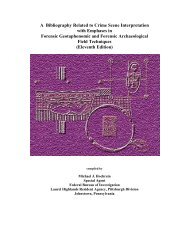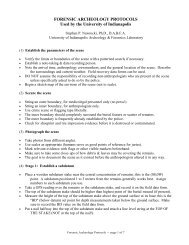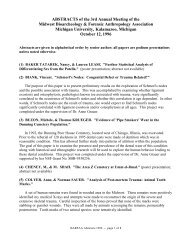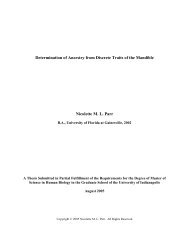Abstracts - University of Indianapolis Archeology & Forensics ...
Abstracts - University of Indianapolis Archeology & Forensics ...
Abstracts - University of Indianapolis Archeology & Forensics ...
You also want an ePaper? Increase the reach of your titles
YUMPU automatically turns print PDFs into web optimized ePapers that Google loves.
This paper presents the results <strong>of</strong> the analysis <strong>of</strong> the teeth excavated at Sa'ad, a portion <strong>of</strong> a larger<br />
analysis <strong>of</strong> the bioarchaeology <strong>of</strong> Sa'ad. Data includes information on the minimum number <strong>of</strong><br />
individuals, caries rates, hypoplasias, and the implications on general health and disease <strong>of</strong> this<br />
population. It specifically addresses the treatment <strong>of</strong> commingled dental remains and their place in the<br />
reconstruction <strong>of</strong> past life, focusing on data collection and organization within a database. Funding for<br />
excavation and analysis was provided by the King Fahd Middle East Studies Program, <strong>University</strong> <strong>of</strong><br />
Arkansas, Fayetteville and Yarmouk <strong>University</strong>, Deanship <strong>of</strong> Graduate Studies and Institute <strong>of</strong><br />
Archaeology and Anthropology.<br />
(31) WOLVERTON, Steve. "Ursids, Artifacts, and Caves: Mortality Implications." (poster<br />
presentation)<br />
European cave deposits <strong>of</strong>ten contain the remains <strong>of</strong> extinct cave bears (Ursus spelaeus and U.<br />
deningeri) and artifacts or human remains. Two twentieth-century explanations for the apparent<br />
association <strong>of</strong> the remains and artifacts are: (1) late Pleistocene hominids preyed upon the bears, and<br />
(2) late Pleistocene hominids and bears occupied the caves at different times thus making the remains<br />
and artifacts appear behaviorally associated when they are not. The former option is dismissed in most<br />
cases based on taphonomic criteria and ursid mortality data. In caves with multiple entrances -<br />
particularly cases where at least one entrance is a vertical shaft comprising a natural trap - another<br />
option serves to better explain the presence <strong>of</strong> ursid remains and artifacts in the same deposits. Ursid<br />
bone assemblages created by accidental entrapment <strong>of</strong> bears in vertical shafts result in a distinctive<br />
mortality pattern. This pattern reveals proportionally more prime adult individuals than expected in a<br />
living population. A consideration <strong>of</strong> North American black bear (U. americanus) physiology and<br />
behavior reveals that this distinctive mortality pattern should be expected from natural trap<br />
assemblages. thus, in assemblages from caves with horizontal and vertical entrances, mortality data<br />
can be used to decipher whether ursids died from natural hibernation deaths, human predation, or<br />
accidental falls through vertical shafts.<br />
Copyright © 2000 by the Individual Authors<br />
The authors grant permission for this document to be copied and distributed for personal and<br />
educational use as long as proper citation is given. Commercial use <strong>of</strong> this document is forbidden<br />
without the prior consent <strong>of</strong> the authors.<br />
Suggested citation <strong>of</strong> individual abstracts (example): Baker A (2000). Analysis <strong>of</strong> cremains from<br />
the Fox Hollow Farm (abstract). Presented at the 7th Annual Meeting <strong>of</strong> the Midwest<br />
Bioarcheology & Forensic Anthropology Association, Columbia MO. <strong>University</strong> <strong>of</strong> <strong>Indianapolis</strong><br />
<strong>Archeology</strong> & <strong>Forensics</strong> Laboratory (http://archlab.uindy.edu).<br />
Last update 7-1-06<br />
BARFAA <strong>Abstracts</strong> 2000 -- page 11 <strong>of</strong> 11








